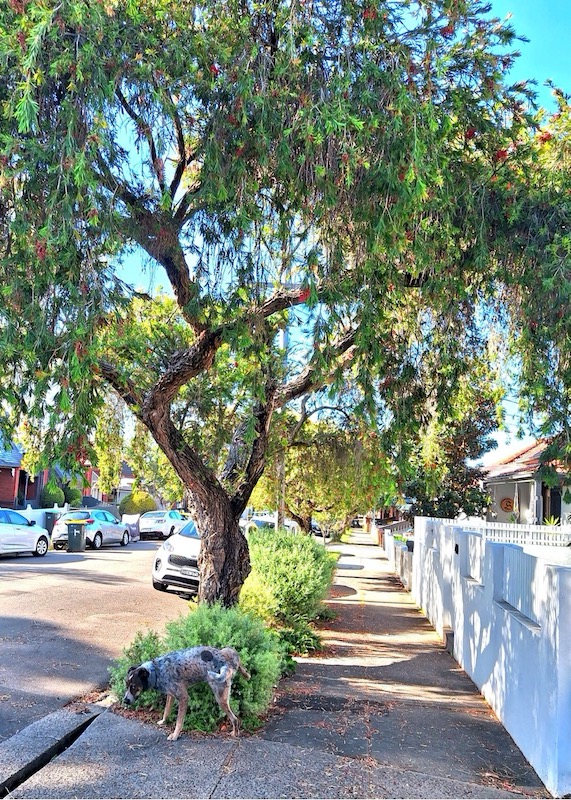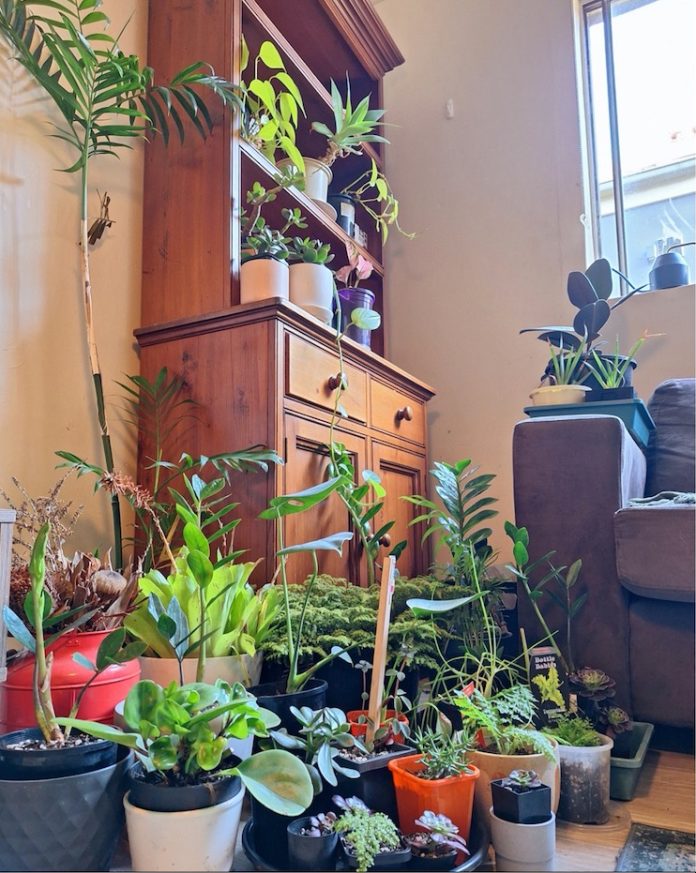“Kipper, heel!” He wasn’t listening. He was too distracted.
It was the first dog we’d seen this cold and drizzly winter’s morning. Ears pricked, he couldn’t ignore the unmistakeable jingle of another dog’s collar tapping against its metal name tag.
He managed to catch a glimpse of the West-Highland Terrier through a gap between parked cars. He stood firm, hoping the owner would let their dog cross the road for a quick sniff, but the jingling soon disappeared. Both knowing there was unlikely to be anything else as interesting for the rest of our walk, we were disappointed.
I called him to heel, again, and we kept on walking.
Inner-west Sydney streets are boring in the early morning, especially when it’s raining. Step after step, house after house, parked car after parked car, tree after tree. The drizzle became torrential just a block from home. Now agitated and despondent, as well as bored, we began the obligatory, but unnecessary, sprint home through the rain. We were already soaked.
It was May 2022 and everyday felt indistinguishable from the next. I would wake-up, walk Kipper, work, study, walk Kipper, cook, shower, and sleep. Life was lacklustre and not much piqued my interest. I’d gone back to university at the start of the year to break the monotony. So far it hadn’t worked, but something was about to change.
Back from the walk, I begrudgingly decided to catch up on a few lectures for a core biology subject. With a warm cup of Bushell’s in one hand, my MacBook open, headphones on, and Kipper asleep beside me on the couch, his wet stench permeating every nook of my bland living room, I began clicking my way through Sydney Uni’s Canvas site.
I still wasn’t sure where the degree was taking me. I daydreamed of working in megafauna conservation efforts in sub-Saharan Africa, becoming an exotic species veterinarian, or starting an animal rescue.
The most interesting area of biology concerns the animal kingdom, right? Those things that move, and with which we humans also identify. Sure, there are plants, bacteria, and fungi, but animals are the most important… right? Anyway, I found the page. I was up to Week 11, Lecture 22a: ‘Plant Blindness’. I set the playback speed to 2x and pressed play.
***
Plant blindness is a phenomenon, first described by Wandersee and Schussler in 1999, where individuals fail to notice and appreciate the existence, abundance, and importance of plants in their everyday lives.
“What do you see there?” asks Dr Matthew Pye, as the first slide of his recorded lecture appears. Dr Pye is a staff member at Sydney University’s School of Life and Environmental Sciences and the coordinator and lecturer of the unit ‘Life & Evolution’. He has a calm voice and his way of speaking, a mixture of colloquialisms and scientific language, helps narrow the daunting gap between student and scientist.
The slide shows a photo of a giraffe on the African savannah, the background littered with Umbrella Thorn Acacias. “A giraffe?” I think to myself. He right clicks and selects ‘Next Slide’. “What do you see in that image?” he asks, my screen now showing two lion cubs camouflaged among tall grass. “Some lion cubs” I say to myself, puzzled at the simplicity of his questioning. Surely there’s not much more to say than that. I pause the lecture and set the playback speed to default. I press play.
The next slide shows a photo of a lion laying in a tree. He probes again: “What do you see in that image?”. I now get the sense he’s asking rhetorically and my answer, “a lion in a tree”, is wrong. After a short pause he continues. “I see Kigelia africana, the sausage tree from Africa.”
I pause the lecture and lean into my screen to get a closer look. “Woah” I whisper, eyes wide. The sausage-esque fruits were massive, like enormous, elongated sweet potatoes, some as large as the lion’s limbs, hanging from branches by long rope-like stems, called peduncles. I had never seen a plant so remarkable.
But this wasn’t true. I had been seeing remarkable plants my whole life. Not only had I been seeing them, but I had also been relying on them. Plants provide us with the fibres that make our clothing, the chemical compounds for our medicines, and their ability to turn the sun’s light energy into carbohydrates is the primary reason we and our animal counterparts have oxygen to breathe and food to eat.
Simply put, if it weren’t for plants we wouldn’t be here at all.
So why does plant blindness exist? Wandersee and Schussler claim it’s the sessility, unthreatening nature, elongated timescales, and comparatively homogenous morphology of plants that explains our oversight. In the lecture, Dr Pye cites experiments that reveal people are better at accurately identifying animals as opposed to plants when shown a rapid sequence of images.
“We are predisposed, genetically, to detect movements in things because the movement may indicate a danger.” He speaks forgivingly; it’s not our fault we are biased. The solution he offers, although simple, is not necessarily easy. We must check our own biases.
I remember my walk that morning with Kipper and how stimulated we were after sensing movement. I find the image of the sausage tree and then look around my bare living room. I want to be plant aware. I didn’t know this then, but with botanical competence comes the intense understanding of our planet’s precarious position.

According to the World Economic Forum, plants account for 80 per cent of global biomass. They are the setting for most of the planet’s ecosystems and are key sequesters of atmospheric carbon, keeping the planet hospitable to life. But the exponential increase of carbon in the atmosphere since the industrial revolution, coupled with incessant deforestation, has left a surplus of emissions, contributing to climate change.
If each of us checked our biases and valued plants more, funding and political support for more effective solutions like reforestation and ecosystem conservation wouldn’t be as hard to come by compared to single species initiatives like the NSW Koala Strategy. It’s nonsensical that despite comprising approximately 75 per cent of Australia’s threatened species list, plants consistently receive less funding than their animal dependants.
It’s now October 2023 and I’m at the end of the second year of my Bachelor of Science. Dr Pye’s lecture inspired me to take the university’s Botany unit earlier in the year and enrol in a Statement of Attainment in Horticulture and Land Management at TAFE NSW. I’ve met lots of new people through plants, in all of whom I’ve noticed a degree of patience and empathy, and my walks with Kipper are no longer boring but full of humbling bewilderment, learning, and application (even in the rain).
***
I wake to another morning, and another walk with Kipper. As usual, he bursts to life when I open the front door – barking, wagging his tail, running back and forth along the side of our duplex. It’s spring in Sydney, the time of year when the morning sun is warm, but the air is still cool. All around, the streets are lined with Callistemon viminialis. In the past week these weeping trees have adorned themselves with their beautiful red bottle-brush inflorescences. Rainbow lorikeets chirp politely, moving from brush to brush, tree to tree, lapping up nectar. Their beaks now inadvertently caked in microspores, the colourful birds have become vectors for pollination.
I look down at Kipper. He doesn’t care; he’s pissing on a tree.
Although I love Kipper with all my heart, he doesn’t have the ability to overcome plant blindness. But as humans we all do. So next time you’re outside don’t be like Kipper. Notice your providers: smell them, touch them, learn their names and function. And get those close to you to do it too. Not only will it help the world to recover, but, in the words of Dr Pye’s lecture, “your life will become richer, I promise you”.


